What Do I Need To Start Aquascaping
Aquascaping transforms an ordinary aquarium into a stunning underwater landscape. Unlike traditional fish tanks that prioritize fish, aquascaping focuses on the creative arrangement of hardscape (stones and wood) and softscape (plants) to mimic scenes from nature, like a solitary tree in a forest clearing, all within the confines of an aquarium.
The appeal of aquascaping lies in its versatility: you can start with a small, simple setup that’s both easy to create and maintain, yet incredibly eye-catching and full of life. Even a tank without animals, designed in styles such as the minimalist Japanese Iwagumi inspired by zen stone gardens, offers a fascinating hobby. These miniature ecosystems, when inhabited by creatures like shrimp or snails, become lively, ever-changing worlds.
Aquascaping fans can find a plethora of information on the internet, which is filled with communities and tools. In order to help you decide if aquascaping is the correct pastime for you, this article attempts to provide a succinct, approachable overview of the key components and factors.
. Despite its beauty, aquascaping does demand some effort and understanding to truly thrive.
Starting Your Aquascaping Journey: What Do I Need To Start Aquascaping
There are a few key considerations if you enjoy simplicity and are thinking of making your own aquascape. While it’s a pleasant hobby, aquascaping requires time and dedication.
You should set aside roughly an hour a week for upkeep in order to maintain your aquascape looking lovely and in good condition. To avoid algae buildup, this entails cleaning the tank, the machinery, and pruning the plants.
. Neglecting this routine can lead to algae issues, putting your plants and animals at risk. Regularly changing about 50% of the water with fresh, room-temperature water is also crucial since aquariums don’t have a natural way to flush out waste and chemicals.
Choose a Permanent Spot Carefully: Remember, even small aquariums can be quite heavy once filled. So, it’s important to select a suitable, long-term spot for your setup right from the start. Moving an established aquascape can be a challenge you’d likely prefer to avoid, especially if you’re planning to move homes soon.
Patience is Your Best Friend: Aquascaping is not a hobby for the impatient. After setting up your tank, it can take weeks or months for the plants to flourish and the initial algae phase to pass. Adjustments like changing light levels or adding water supplements also take time to show results. If you’re someone who finds it hard to stick with one task for long, aquascaping might teach you the value of patience. It’s about slowly but surely creating a little piece of nature you’re responsible for.
Looking back, you’ll see how patience and dedication can lead to something truly amazing. The beautiful, thriving aquascape you’ll eventually have is a testament to your effort and care—a lesson in how commitment and patience can yield incredible rewards.
Getting Started with Aquascaping: What You’ll Need
Entering the world of aquascaping can be thrilling, and you may be wondering what precisely you’ll need to start with a modest, doable aquascape. Let’s dissect it.
The Aquarium
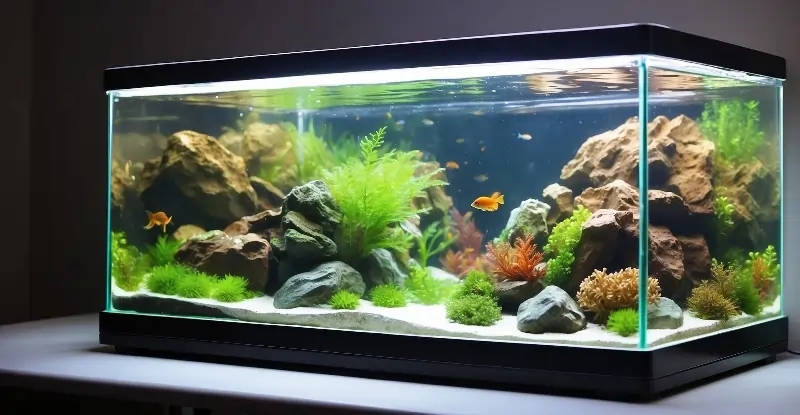
You will need a tank first. Nano aquariums, with capacities of no more than thirty liters, are well-liked for their portability and low care requirements. It’s crucial to keep in mind, though, that smaller tanks may be more susceptible to variations in water quality and temperature. I myself use two rather steady containers: a 30x60x20cm tank and a 30x30x30cm cube.
However, they do require extra care in the summer to manage temperature and evaporation. Always place a soft mat under your tank to prevent any stress on the glass and protect it from uneven surfaces.
The Water Filter
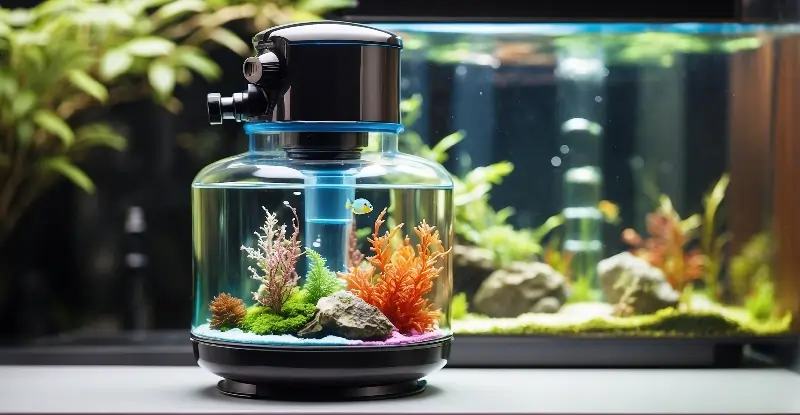
A filter is essential for keeping your water clean and supporting healthy bacteria that aid in water quality. There are several types:
Internal filters fit inside your tank but can take up space and might detract from your aquascape’s look.
External filters sit outside the tank, keeping the setup tidy and adding a pleasant water movement. They’re great for larger setups.
Hang-on filters, which I use, attach to the side of the tank and are excellent for up to 60 liters. They’re discreet and help agitate the water surface to remove impurities.
The Lighting
Proper lighting is crucial for plant growth and color. LED lights are a favorite for their efficiency and longevity. They can be mounted directly on the tank or suspended above. Using a timer to simulate natural day/night cycles, with about 6–8 hours of light daily, helps prevent algae growth and ensures your plants are healthy. Adjust the light duration based on your specific plants’ needs.
The CO2 System
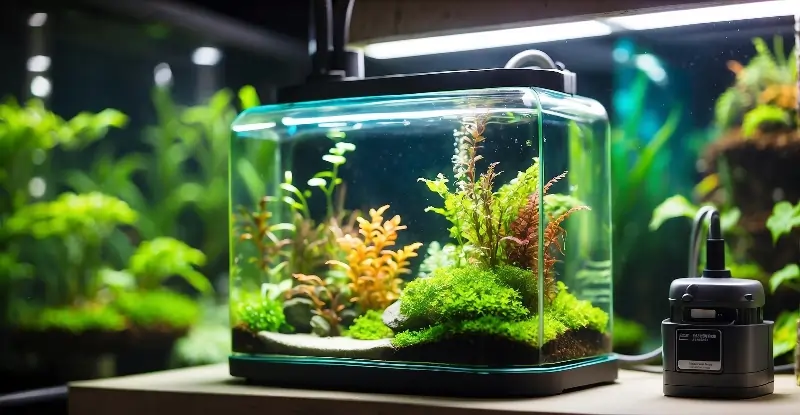
While not strictly necessary for basic setups, a CO2 system can significantly enhance plant health and color. Plants need CO2 to photosynthesize, and while water naturally contains some CO2, adding more can boost plant growth. For small tanks, nano CO2 systems are perfect, with bottles needing a monthly change. If you have a larger setup, consider a refillable CO2 system. Remember to turn off the CO2 at night, as plants only use it when the light is on.
The Water
Naturally, an aquascape would be incomplete without water. For freshwater aquascapes, tap water is often acceptable, but make sure it doesn’t contain any dangerous substances like chlorine. Water conditioners can make tap water suitable for your tank if you’re not sure. Ensure any added water is the right temperature for your aquatic life. Some advanced aquascapers even mix their own water using osmosis systems for the perfect balance.
Substrate: The Aquascaping Soil
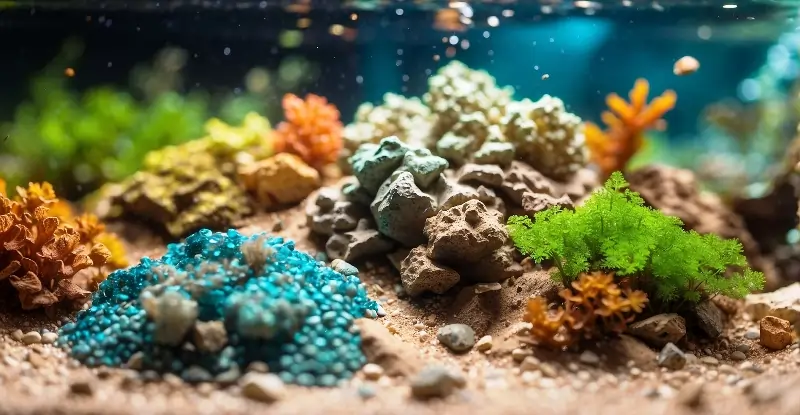
Consider the substrate in your aquarium as more than simply the bottom layer; it serves as the framework for the development of your aquatic plants. Choosing nutrient-rich aqua soils that promote plant development or going for a more organic look with sand or gravel will have a significant impact on the underwater garden’s overall appearance and health.
It’s crucial to take into account both the aesthetic effect you want for your aquascape and the requirements your plants need to flourish because every form of substrate has advantages of its own. The ecosystem in your aquarium is affected by the substrate you choose, which also affects the general health and balance of the plant life.
Lighting: The Sun of Your Underwater World
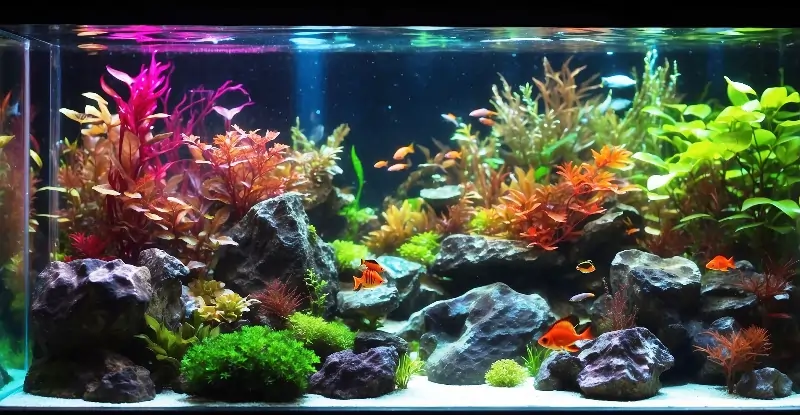
Your plants depend on aquatic illumination to support photosynthesis, which maintains them vibrant and healthy. It goes beyond simply designing an eye-catching undersea scene. An increasing number of aquascapers choose LED lights due to their energy efficiency and longer lifespan. However, there isn’t a one-size-fits-all solution because different plants have different light requirements. While bright lighting suits some people well, others may prefer quieter, softer lighting.
Ensuring that every plant in your aquascape receives the precise nutrients it needs to flourish nicely may be achieved by selecting the appropriate lighting in terms of both intensity and color spectrum. Thus, when designing the lighting in your aquarium, consider it the sun of your own little aquatic ecosystem, necessary to keep life alive.
Plants: The Life of Aquascaping
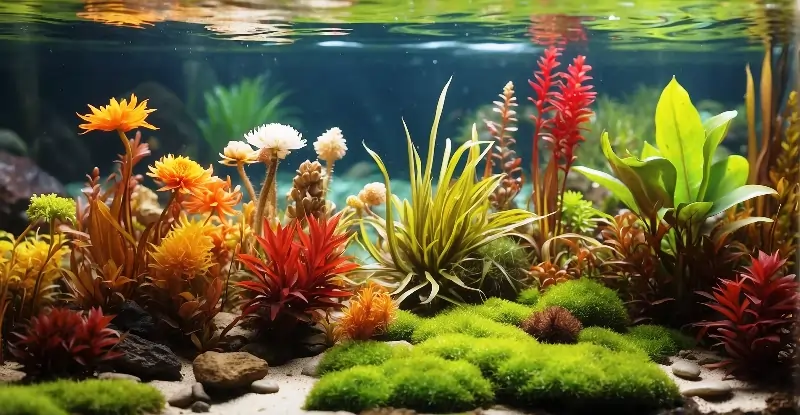
Plants are the lifeblood of your underwater garden in the world of aquascaping; they are more than just decorative elements. Their addition of vivid hues, diverse textures, and a lively vibe turns your tank into a vibrant habitat. Whether it’s the lush carpeting plants that cover the aquarium floor or the majestic ones that stretch up towards the surface, every plant contributes its own unique touch, creating layers and intricacies in your aquatic landscape. Before diving in, take some time to explore which species will complement the style and conditions of your aquascape.
If you’re new to this hobby, leaning towards resilient plant types can be a great way to start. They tend to be more adaptable and can thrive even as you’re getting the hang of things. Remember, each plant you choose breathes life into your aquascape, making it a captivating display of nature’s beauty.
Hardscape Materials: The Bones of Your Layout
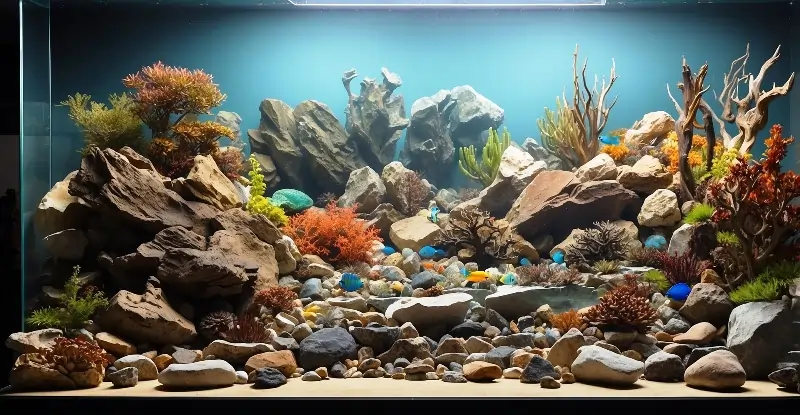
Rocks, driftwood, and other hardscape materials provide structure and form to your aquascape. They create the skeleton around which your plants will grow and thrive. The choice of materials can set the tone of your aquascape, from rugged mountainous layouts using stones like Seiryu or Ohko, to serene forest scenes crafted with driftwood pieces. Placement is key, and adhering to principles like the golden ratio can help achieve a natural and pleasing composition.
Starting Your Journey with Aquascaping Now that you have these five necessities, you may get started with aquascaping. Recall that aquascaping is a combination of art and science. Your allies are practice and patience. Try new things, take lessons from your mistakes, and most of all, have fun while making your own aquatic environment.K
FAQs on What Do I Need To Start Aquascaping
Q: Do I need a special type of aquarium for aquascaping?
A: No, you can start with any aquarium, but ensure it’s the right size for your vision and space.
Q: How important is the substrate in an aquascape?
A: Very! The right substrate supports plant growth and affects the water chemistry.
Q: Can I use any light for my aquascape?
A: It’s best to use aquarium-specific lights that cater to the needs of your plants and design.
Q: Where should I place hardscape materials in my tank?
A: Use principles like the golden ratio for a natural look, ensuring they form a solid foundation for plants.
Blog Post Conclusion–What Do I Need To Start Aquascaping
Discovering the skill of aquascaping may turn your aquarium into a living work of beauty by combining creativity and nature. Your underwater landscape can be started with the correct aquarium, substrate, lighting, plants, and hardscape materials. To become an expert at this lovely pastime, keep in mind that aquascaping is a learning and development process.
We would like to hear about your experiences, triumphs, and lessons gained from aquascaping. Your experiences add to our collective understanding and encourage others to take on new aquascaping challenges. Together, let’s expand our community one magnificent aquascape at a time.
Happy aquascaping!
